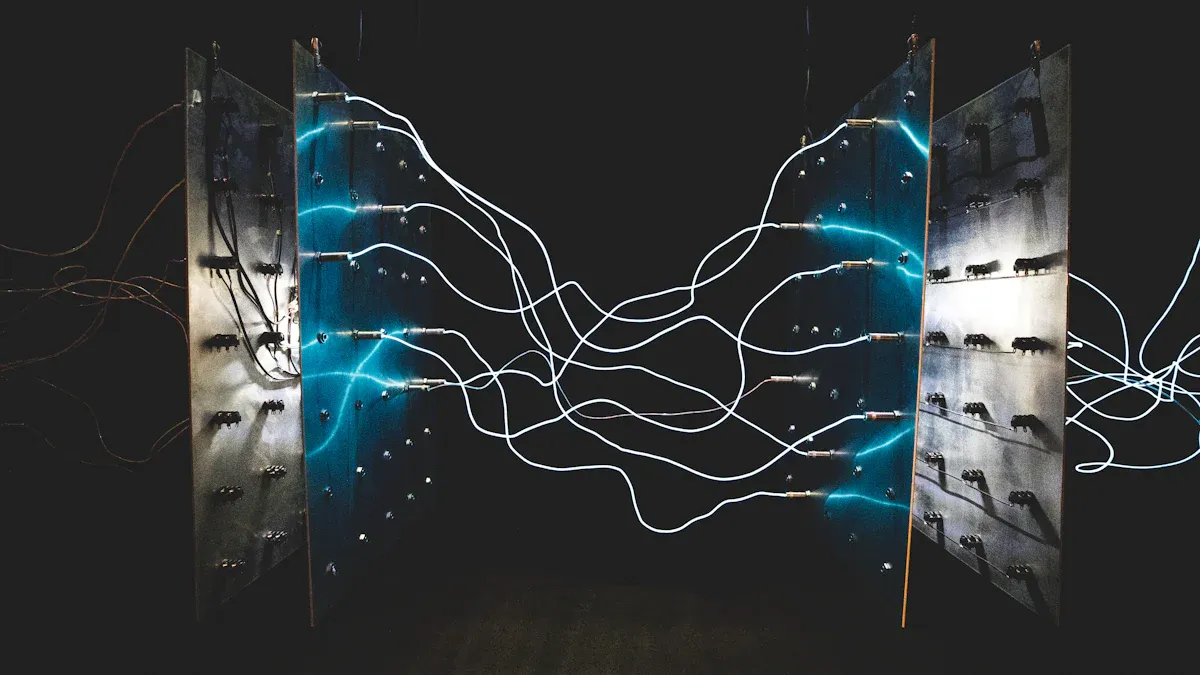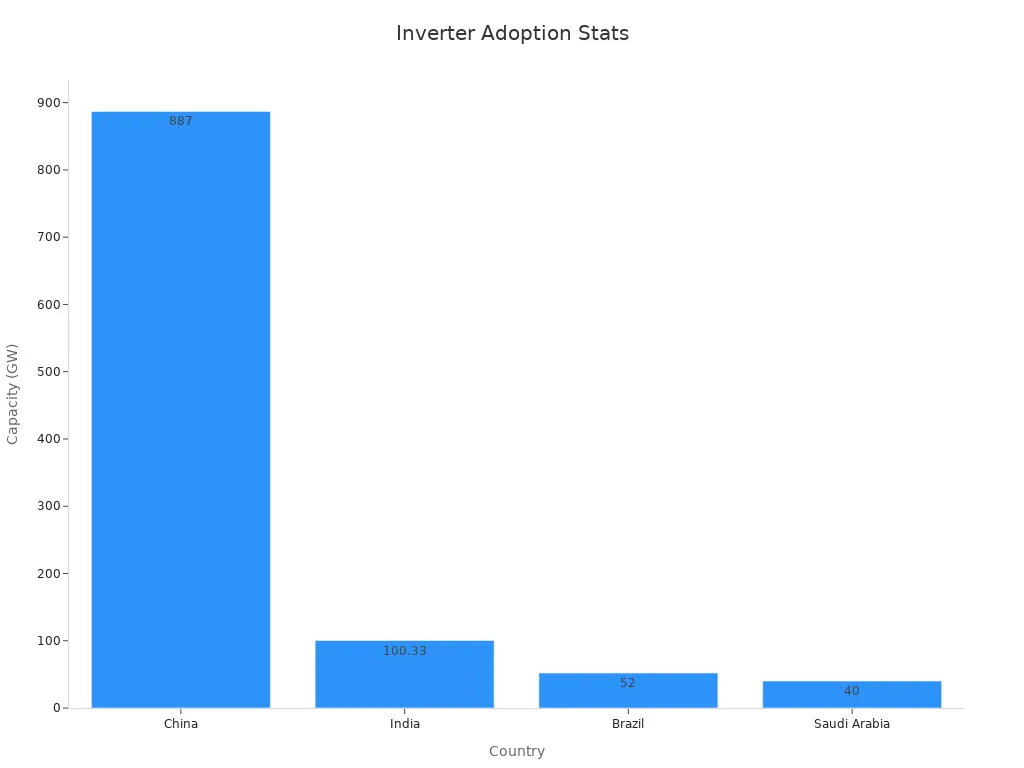The evolution of DC to AC inverter technology in 2025

In 2025, dc to ac inverter technology has reached new heights with advanced materials and smarter control systems. The inverter now stands at the center of modern energy systems, quietly turning direct current from solar panels into usable alternating current for homes and businesses. Imagine a translator who helps two people speak different languages understand each other; the dc to ac inverter acts as that translator for electricity, making renewable energy part of daily life.
Key Takeaways
DC to AC inverters convert direct current from sources like solar panels into alternating current used by homes and businesses.
Modern inverters use advanced materials and smart controls to improve efficiency, reduce energy loss, and provide stable power.
Inverters play a key role in renewable energy, smart grids, and electric vehicles by enabling clean and reliable electricity use.
New technologies like artificial intelligence help inverters adjust power flow in real time, making energy systems smarter and more reliable.
Future inverter designs will be smaller, more efficient, and better at handling different energy sources, supporting a sustainable energy future.
DC to AC Inverter Science
Conversion Basics
A dc to ac inverter changes direct current into alternating current. Direct current flows in one direction, like water moving through a straight pipe. Alternating current switches direction many times each second, similar to waves moving back and forth. Most home appliances and power grids use alternating current because it travels efficiently over long distances.
The process of dc to ac conversion starts with a steady flow of electricity from a source such as a solar panel or battery. The inverter takes this direct current and uses electronic switches to create a wave-like pattern. This pattern matches the alternating current needed by household devices.
Tip: Think of the inverter as a skilled conductor leading an orchestra, turning a single note (direct current) into a full symphony (alternating current).
Core Principles
The science behind inverters relies on switching and timing. The inverter rapidly turns the flow of direct current on and off. This action creates pulses that form the basis of alternating current. The timing and shape of these pulses determine the quality of the output.
Engineers design inverters to produce a smooth and stable alternating current. They use mathematical models to control the switching process. The goal is to make the output as close as possible to the ideal sine wave used in power grids.
A table below shows the main differences between direct current and alternating current:
Feature | Direct Current (DC) | Alternating Current (AC) |
|---|---|---|
Direction of Flow | One direction | Changes direction |
Common Sources | Batteries, solar | Power grid, generators |
Main Use | Electronics | Homes, industry |
Switching Devices
Modern inverters use advanced electronic switches. Two common types are MOSFETs (Metal-Oxide-Semiconductor Field-Effect Transistors) and IGBTs (Insulated Gate Bipolar Transistors). These devices act like fast, precise gates. They control the flow of electricity with high efficiency and reliability.
MOSFETs work well at high speeds and low voltages. Engineers often use them in small inverters.
IGBTs handle higher voltages and larger currents. They appear in bigger systems, such as those for solar farms or electric vehicles.
The choice of switching device affects the inverter’s performance, efficiency, and size. In 2025, new materials and designs have made these switches even faster and more durable.
Modulation Techniques
To create a smooth alternating current, inverters use modulation techniques. The most common method is Pulse Width Modulation (PWM). PWM controls the width of each pulse sent by the switches. By changing the width, the inverter shapes the output to look like a sine wave.
Another advanced method is Space Vector Modulation (SVM). SVM uses mathematical calculations to optimize the switching pattern. This technique improves efficiency and reduces unwanted electrical noise.
Note: Modulation techniques help inverters deliver clean power that matches the needs of sensitive electronics and modern appliances.
Engineers continue to refine these techniques. Their goal is to make inverters more efficient, quieter, and better suited for renewable energy systems.
Inverter Technology Evolution

Early Designs
Engineers began developing the first inverters in the early 20th century. These early devices used mechanical switches called rotary converters. The machines spun at high speeds to change direct current into alternating current. Early inverters were large, noisy, and required regular maintenance.
The first power inverter designs relied on vacuum tubes. These tubes controlled the flow of electricity but generated a lot of heat. The devices often failed after long use. Early inverters could not handle much power, so people used them only for small applications.
Early inverters paved the way for modern energy systems, even though they had many limitations.
Key Milestones
Over time, engineers improved inverter technology. They replaced vacuum tubes with solid-state components like transistors. This change made inverters smaller, more reliable, and more efficient.
Some important milestones include:
Introduction of Transistors (1950s-1960s): Transistors replaced vacuum tubes. Inverters became lighter and more durable.
Development of MOSFETs and IGBTs (1970s-1980s): These new switches allowed inverters to handle higher voltages and currents. Power inverter systems became more common in industry and homes.
Adoption of Pulse Width Modulation (PWM): PWM improved the quality of alternating current output. Devices could now power sensitive electronics.
Digital Control (1990s-2000s): Microprocessors gave engineers precise control over inverter operation. Systems became smarter and more adaptable.
A table below highlights these milestones:
Decade | Key Innovation | Impact on Inverter Technology |
|---|---|---|
1950s-1960s | Transistors | Smaller, more reliable inverters |
1970s-1980s | MOSFETs, IGBTs | Higher power handling, efficiency |
1990s-2000s | Digital control, PWM | Smarter, cleaner power output |
2025 Breakthroughs
In 2025, the dc to ac inverter has reached a new level of performance. Engineers use advanced materials like silicon carbide and gallium nitride. These materials allow inverters to switch faster and waste less energy as heat.
Modern inverters now include artificial intelligence. AI helps the inverter adjust its operation in real time. The system can predict changes in energy demand and supply. This makes the power inverter more efficient and reliable.
For example, a smart inverter in a solar home can detect when clouds block the sun. It quickly adjusts to keep the power steady for all devices.
Engineers have also improved the way inverters connect to the grid. New designs support two-way communication. The inverter can send and receive data from the utility company. This helps balance energy use across neighborhoods and cities.
In 2025, the inverter has become a key part of renewable energy systems. It helps blend solar, wind, and battery power into the grid. The latest breakthroughs make alternating current from renewable sources as stable and clean as traditional power plants.
Inverter Applications
Renewable Energy
Inverters play a vital role in every modern solar energy system. They convert the direct current from solar panels into usable electricity for homes and businesses. Many regions now rely on inverters to support their clean energy goals. For example, China leads the world with 887 GW of installed solar capacity. India follows with over 100 GW. North America and Europe also show strong growth in residential and commercial solar installations. These trends reflect the increasing demand for efficient inverter technology.
Region | Key Market Share / Installed Capacity Statistics | Supporting Factors for Inverter Adoption |
|---|---|---|
Asia Pacific | China: 887 GW installed solar capacity (highest globally) | High solar penetration; leading manufacturing hub for solar technologies |
India: 100.33 GW installed solar capacity (as of Jan 2025) | Rapid solar capacity growth | |
North America | Growing residential solar installations; strong government incentives | Favorable policies; technology advancements; demand for clean energy |
Europe | Significant rise in solar capacity due to energy crisis and policies | Falling technology prices; environmental awareness |
Latin America | Brazil: 52 GW operational solar capacity | Clean energy transition; government climate goals |
Middle East & Africa | Saudi Arabia targeting 40 GW solar PV by 2030 under Vision 2030 | Plentiful solar resources; renewable energy emphasis |
Market Segments | Commercial solar installations dominate market share | Need for high efficiency and grid support |
Residential solar installations growing fastest | Increasing homeowner adoption for energy self-sufficiency and efficiency |

In many countries, the power inverter has become essential for integrating renewable sources into the grid.
Smart Grids
Smart grids use digital technology to manage electricity flow. Inverters help these grids balance supply and demand. They allow two-way communication between homes, businesses, and utility companies. This technology supports the use of renewable energy and improves grid stability. Smart inverters can respond quickly to changes in energy production or consumption. They help prevent blackouts and maintain reliable service.
Electric Vehicles
Electric vehicles depend on inverters to operate their motors. The inverter converts stored battery power into the form needed for driving. Modern vehicles use advanced inverters for better efficiency and performance. Fast charging stations also rely on this technology. As electric vehicle adoption grows, the demand for reliable inverters increases.
Consumer and Industry
Inverters power many devices in homes and factories. Homeowners use them in backup systems and solar installations. Industries depend on inverters for running machines, controlling motors, and saving energy. The technology supports automation and improves productivity. As more people seek energy independence, the role of inverters in daily life continues to expand.
Future of Inverter Technology
Trends Beyond 2025
Engineers expect inverter technology to keep evolving after 2025. They see a future where inverters become even smarter and more efficient. Many experts predict that artificial intelligence will play a bigger role. AI can help inverters learn from energy patterns and make real-time decisions. This will allow energy systems to respond quickly to changes in demand or supply.
New materials will also shape the next generation of inverters. Researchers focus on wide-bandgap semiconductors, such as gallium nitride and silicon carbide. These materials allow devices to operate at higher temperatures and voltages. As a result, inverters will become smaller, lighter, and more reliable.
⚡ Tip: Smaller and more efficient inverters can help renewable energy reach more homes and businesses.
Some trends to watch include:
Integration with smart home systems
Improved cybersecurity for grid-connected devices
Support for bidirectional energy flow, enabling homes to send power back to the grid
Research and Challenges
Scientists and engineers continue to face challenges as they push inverter technology forward. One major challenge involves managing heat. High-performance inverters generate a lot of heat, which can damage components if not controlled. Researchers work on better cooling systems and new materials to solve this problem.
Another challenge is ensuring compatibility with different energy sources. As more homes and businesses use solar panels, batteries, and electric vehicles, inverters must handle a variety of inputs. Engineers design flexible systems that can adapt to these changes.
A table below highlights some key research areas and ongoing challenges:
Research Area | Main Challenge |
|---|---|
Advanced materials | Heat management |
AI and smart controls | Real-time decision making |
Grid integration | Cybersecurity and compatibility |
Scientists believe that overcoming these challenges will help create a more stable and efficient energy future.
Recent years have seen major progress in DC to AC conversion. Engineers introduced advanced materials and smarter controls, which improved efficiency and reliability. These changes support clean energy, electric vehicles, and smart grids. People now experience more stable power in daily life.
Ongoing research promises even greater advances, shaping a future where energy systems become smarter and more sustainable.
FAQ
What is the main job of a DC to AC inverter?
A DC to AC inverter changes direct current from sources like solar panels into alternating current. This process allows homes and businesses to use electricity from renewable sources.
Why do modern inverters use materials like silicon carbide?
Silicon carbide helps inverters switch faster and waste less energy as heat. These materials make inverters smaller, more efficient, and longer-lasting.
How does artificial intelligence improve inverter performance?
Artificial intelligence lets inverters adjust their operation in real time. The system can predict changes in energy use and keep power steady for devices.
Can inverters work with both solar panels and batteries?
Yes. Many inverters today handle power from solar panels and batteries. This flexibility helps homes store energy and use it when needed.
What makes smart inverters important for the power grid?
Smart inverters support two-way communication with the grid. They help balance energy supply and demand, which keeps electricity reliable for everyone.
See Also
In-Depth Analysis Of High-Efficiency Air Conditioning Units
Telecom Cabinet Power Using Grid-Tied Solar Inverter Systems
A Guide To Global Standards For Communication Power Sources
Next-Generation Outdoor Enclosures Designed For 5G Networks
ESTEL’s Intelligent Energy Storage For Microgrid Telecom Cabinets
CALL US DIRECTLY
86-13752765943
3A-8, SHUIWAN 1979 SQUARE (PHASE II), NO.111, TAIZI ROAD,SHUIWAN COMMUNITY, ZHAOSHANG STREET, NANSHAN DISTRICT, SHENZHEN, GUANGDONG, CHINA
